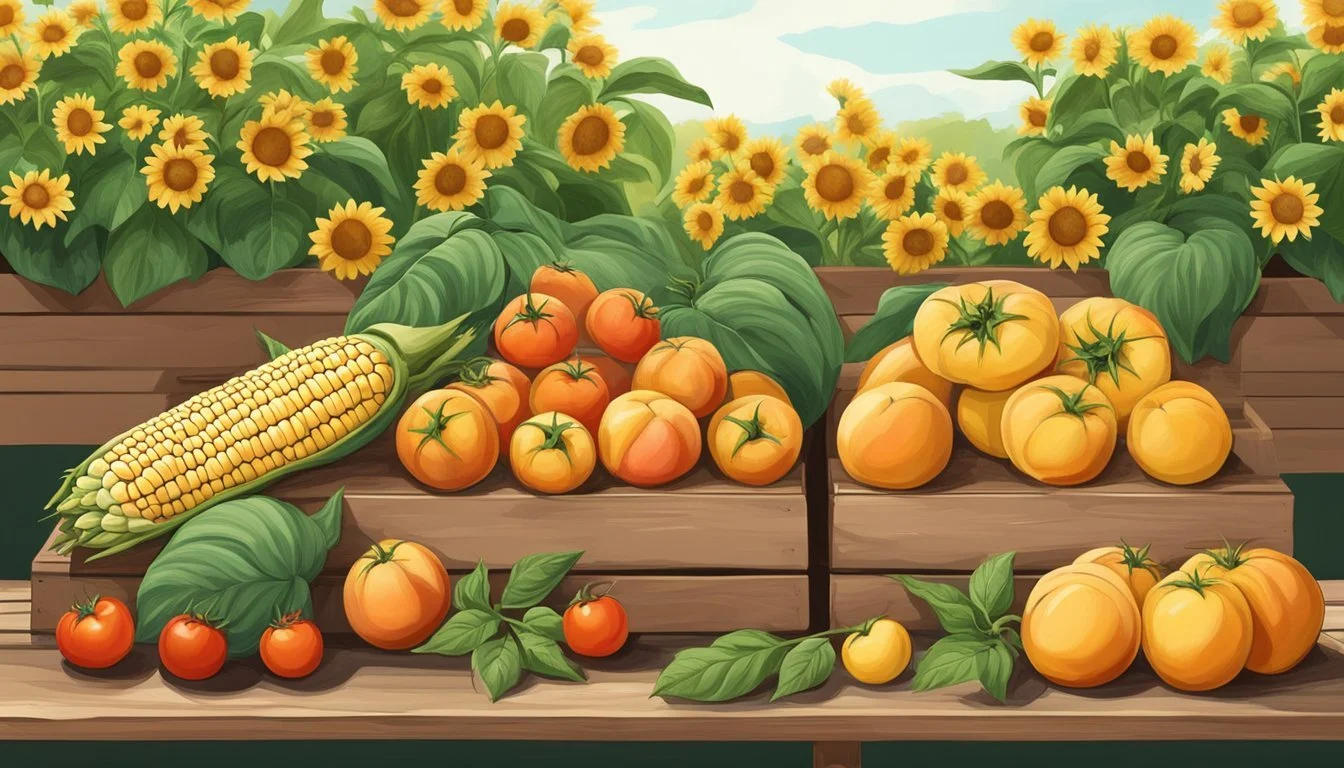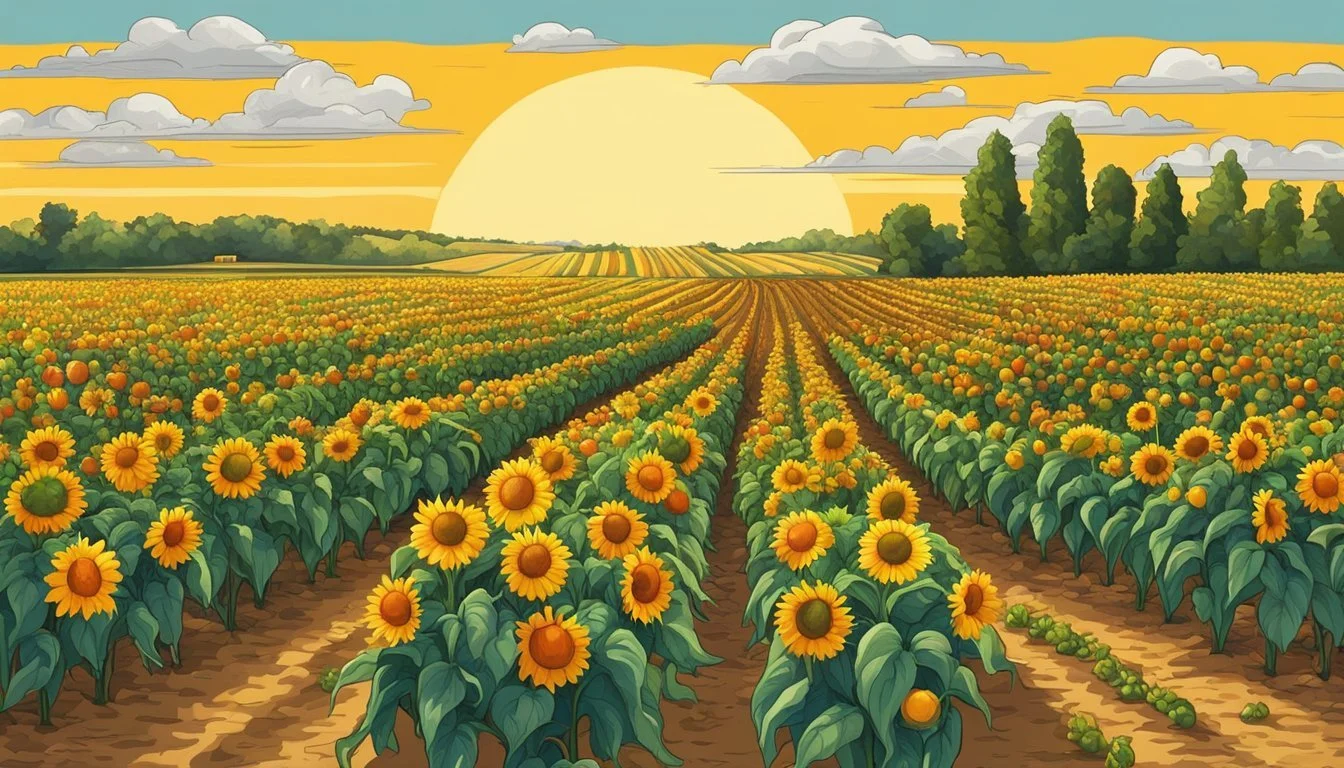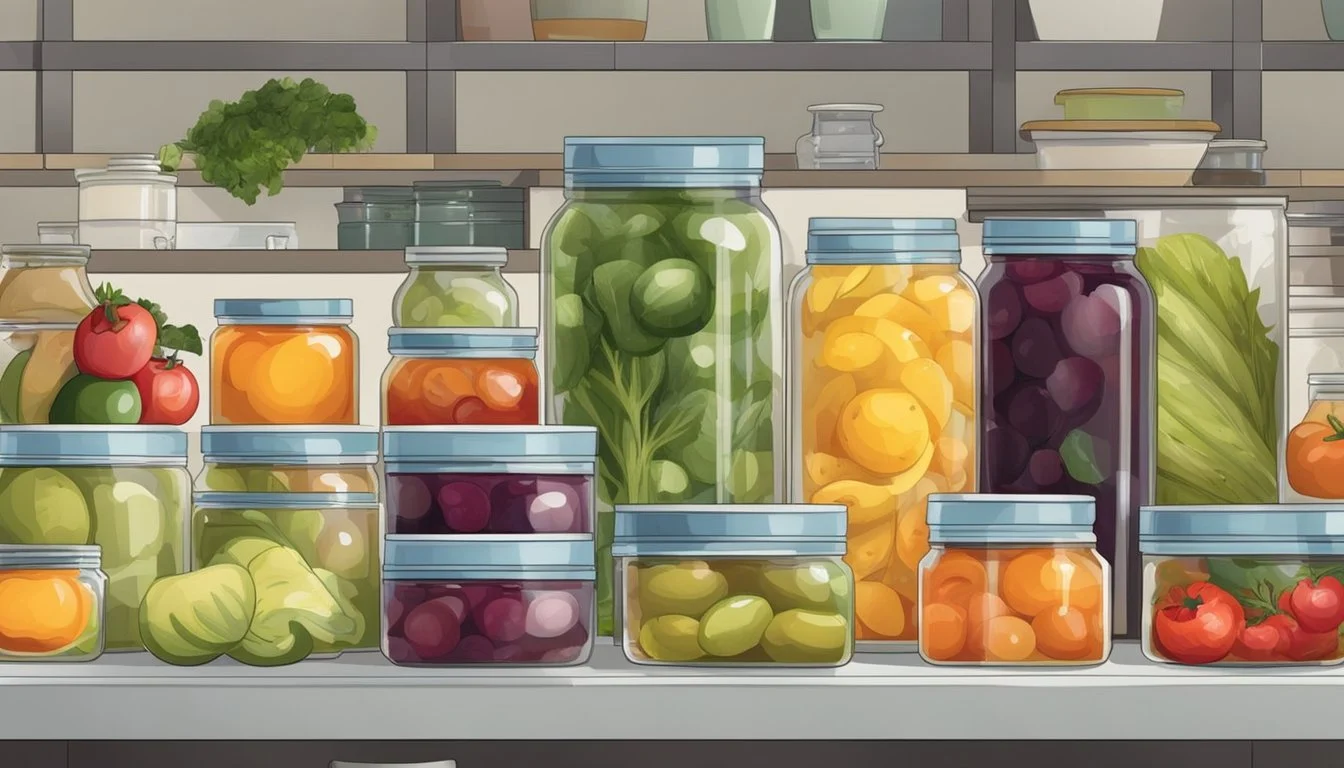Kansas Seasonal Fruit & Vegetables in August
Your Guide to Fresh Produce
This Article is Part of our Kansas Seasonal Fruit & Veg Calendar
August in Kansas is a time of abundant harvest, where the warm days and cool nights provide ideal conditions for a variety of fruits and vegetables to flourish. This is the peak season for many of the state’s agricultural offerings, making it an important month for both farmers and consumers. The bounty includes everything from sweet, plump blackberries and juicy cantaloupes (how long does cantaloupe last?) to an array of hearty vegetables like tomatoes, sweet corn, and peppers.
Farmers' markets and grocery stores across Kansas showcase a rich selection of locally grown produce during this month. Shoppers have the opportunity to enjoy vegetables like cucumbers (how long do cucumbers last?), eggplants (What wine goes well with eggplant?), and onions, each offering farm-fresh flavors that are a testament to the region's fertile soil. Owing to the meticulous cultivation and favorable climate, seasonal fruits such as peaches, plums, and early apples begin to appear, highlighting Kansas as a state that celebrates its seasonal produce.
The onset of late summer does not slow the variety and quality of produce available; instead, it marks a period of transition where late-summer favorites meet the first hints of fall's harvest. From the sun-ripened berries to the first pumpkins of the season, Kansas offers a diverse palette of produce, supporting not only local agriculture but also encouraging healthier eating habits through the availability of fresh, nutritious options.
Seasonality of Fruits and Vegetables in Kansas
In Kansas, August marks a time of abundance in agricultural produce, with a wide range of fruits and vegetables reaching peak maturity, ready for harvest.
Understanding Crop Availability
The growing conditions in Kansas result in a distinct schedule of crop availability. August's warm and mild climate supports the growth of several key crops. Vegetables such as cauliflower and celery (how long does celery last?) thrive in the persistent warmth, often extending their availability into the fall months if early frosts are absent. On the fruit side, cherries (how long do cherries last?) have just ended their season in July, but other fruits like peaches and blackberries are still in full swing.
Crop availability in Kansas is influenced by seasonal weather patterns, which farmers monitor to optimize the planting and harvesting schedules. As a result, the state's agricultural output is aligned with the natural growth cycles, ensuring fresh and nutritious produce.
The Significance of August for Harvesting
August in Kansas is a critical month for harvesting summer crops. It is a time when many vegetables and fruits reach their ideal ripeness, offering flavors that are both rich and diverse. The harvest includes:
Vegetables: Cauliflower and celery, alongside other greens like chard, are abundant. Fields of corn provide their sweetest yield around mid-August.
Fruits: Berries, such as blackberries, are often harvested during this time, and stone fruits, including peaches, deliver their juicy, ripe offerings.
Farmers markets and local grocery stores teem with these seasonal items, reflective of the state's robust farming practices. For residents and chefs alike, August is synonymous with fresh, locally sourced produce that's both flavorful and highly nutritious. The seasonality not only supports the local economy but also ensures that the consumption of fruits and vegetables is at its peak freshness and taste.
Buying Local: Kansas Farmers Markets
August in Kansas offers a bounty of fresh produce that one can acquire directly from the source at numerous farmers markets throughout the state. These markets are not only a hub for obtaining fresh Kansas produce but also serve to bolster the local economy and community ties.
Benefits of Shopping Locally
When consumers choose to shop at local Kansas farmers markets, they support the state's agricultural economy and contribute to the sustainability of small farms. By purchasing directly from Kansas farmers, there is a reduction in the carbon footprint associated with long-distance food transport. Customers generally enjoy fresher produce, often harvested within 24 hours of being available for sale, and have the opportunity to speak with growers about the best practices for storage and preparation to get the most out of their purchases.
Finding Farmers Markets in Kansas
To locate a farmers market near you in Kansas, state resources such as TravelKS.com and FromTheLandofKansas.com provide comprehensive listings. Farmers markets across the state may vary in size and the variety of goods offered, but they all share a common feature: a selection of seasonal fruits and vegetables.
Kansas Grown! Farmers Market, as a notable example, showcases local vendors who offer a wide array of products, including but not limited to:
Fruits: such as peaches, melons, and berries
Vegetables: like tomatoes, cucumbers, and sweet corn
Shoppers can keep abreast of what's currently available and in season by visiting market websites or following their social media pages for the most recent updates on produce offerings.
By frequenting these markets, consumers can indulge in the seasons' best while engaging with their local food system in a meaningful way.
August Fruit Harvest in Kansas
In August, Kansas boasts a bountiful harvest of berries and stone fruits, along with a variety of melons, providing a fresh, flavorful bounty for the local market.
Berry Varieties and Their Peak
Kansas’s climate in August is conducive to the harvesting of several types of berries. Blackberries and blueberries, rich in flavor and antioxidants, are typically at the end of their peak season. They are joined by raspberries, which offer a juicy burst for the palate. These berries are commonly found fresh in local markets and are perfect for jams, pies, or enjoying fresh.
Blackberries: Late season
Blueberries: Ending peak
Raspberries: In season
Stone Fruits and Melons in Late Summer
Stone fruits such as peaches and nectarines reach their ripe, juicy peak in August. They are characterized by their soft flesh and a single large seed or "stone" within. Both fruits are known for their sweet and slightly tart flavors, ideal for eating fresh or incorporating into desserts. Melons, including cantaloupes and watermelon, are also harvested during this time. They are celebrated for their refreshing and hydrating qualities during the hot Kansas summer.
Peaches: Peak season
Nectarines: Peak season
Cantaloupe: In season
Watermelon: In season
These fruits represent the essence of August in Kansas, with farm stands and markets overflowing with the state's seasonal produce.
August Vegetable Harvest in Kansas
August in Kansas marks a bountiful period for vegetable harvesting. Gardeners and farmers across the state gather a diverse array of produce, ensuring a fresh selection for both culinary enthusiasts and local markets.
Root Vegetables and Greens
In the warmer soils of August, root vegetables flourish. Key players include:
Potatoes: A staple in Kansas gardens, varieties such as Russets and Yukon Golds are typically ready to unearth.
Radishes: Fast-growing and crisp, radishes reach their peak, adding a peppery note to salads and dishes.
Greens also take a stand during this month. Swiss chard, known for its vibrant color and nutritional value, offers leaves perfect for sautéing or adding to fresh salads.
Nightshades and Squashes
The summer heat aids in the maturation of a variety of nightshades:
Tomatoes: Rich and plump, they vary from the cherry-sized snacks to the larger beefsteaks.
Eggplant (What wine goes well with eggplant?): With their glossy purple skin, eggplants are excellent for dishes like ratatouille (What wine goes well with ratatouille?).
Peppers: Ranging from sweet bell peppers (What wine goes well with bell peppers?) to hotter varieties, they add flavor and color to every meal.
Squashes become abundant:
Summer squash and zucchini reveal their tender flesh, ideal for grilling or spiralizing.
Winter squashes begin to make an early appearance, hinting at the approaching change in season.
Beans and Okra are also of note:
Green beans and okra present a prime time for picking, boasting tenderness and flavor that can be savored when picked at their peak.
Preparing and Preserving Seasonal Produce
Preserving the bounty of Kansas in August ensures that the flavorful fruits and vegetables can be enjoyed year-round. The techniques of canning, pickling, freezing, and drying transform seasonal harvests into pantry staples, ensuring no part of the harvest goes to waste.
Canning and Pickling
Canning is a method that can extend the shelf life of fresh produce by sealing them in sterilized jars and involves steps including peeling, chopping, boiling, and adding preservatives such as sugar or vinegar. With Kansas' ripe tomatoes, one can make a variety of salsas and sauces, ensuring flavors remain vibrant months later.
Pickling, on the other hand, combines vinegar, water, and salt with produce to create tangy condiments. A simple pickling brine can turn cucumbers into crunchy dill pickles or transform spicy peppers into a condiment that adds zest to salads and sandwiches.
Freezing and Drying
Freezing fruits and vegetables at their peak ripeness helps retain nutritional value and flavor. For instance, sweet corn can be blanched, kernels removed, and then frozen to add a summer-fresh taste to winter meals. Berries, vital for jams and desserts, are best frozen on a tray before being transferred to bags to prevent clumping.
Drying or dehydrating removes moisture from produce, creating snacks like dried apple chips (how long do apple chips last?) or herbs for cooking. Carefully dried fruits (What wine goes well with dried fruits?) can be incorporated into granolas or used in baking to add natural sweetness to a variety of recipes.
Health Benefits and Nutrition of Seasonal Produce
Eating seasonal produce in August ensures that individuals are consuming fruits and vegetables at their peak in both flavor and nutritional value. This aligns with dietary guidance, which underscores the importance of incorporating diverse and nutrient-rich produce into one's diet.
Nutritional Profile of August Fruits
August fruits, like peaches and melons, offer a range of vitamins and minerals that are essential for health. They are typically high in vitamin C, which is vital for immune function, and contain antioxidants that protect against cellular damage. Fruits during this month can also be high in fiber, which aids in digestion.
Peaches: Rich in vitamins A and C, potassium, and dietary fiber. Perfect for a fresh fruit salad.
Melons: A source of hydration and vitamins A and C, with varieties like cantaloupe providing beta-carotene.
Nutritional Profile of August Vegetables
In August, vegetables such as sweet potatoes and green beans are nutrient-dense and can be the cornerstone of any balanced meal. They provide essential nutrients like dietary fiber and a range of vitamins.
Sweet Potatoes: Packed with vitamin A, vitamin C, and manganese. Sweet potatoes are versatile for both savory and sweet dishes.
Green Beans: A source of fiber, vitamin C, and folate. Ideal for a nutritious addition to any salad.
By focusing on these seasonal offerings, consumers can leverage the natural cycle of food to enhance their nutritional intake.
Creative Recipes Using August Produce
In Kansas, August ushers in a plethora of vibrant fruits and vegetables, presenting an opportunity to explore a variety of refreshing salads and hearty main dishes. Chefs and home cooks alike can take advantage of the season's bounty to create dishes that highlight the fresh flavors of locally sourced produce.
Summer Salads and Appetizers
Eggplant Parmesan Bites: Diced eggplant coated in seasoned breadcrumbs, fried until golden, and topped with a slice of Parmesan cheese create bite-sized appetizers that are perfect for any summer gathering.
Bell Pepper Rainbow Salad: Thinly sliced red, orange, and yellow bell peppers tossed with crisp cucumbers, cherry tomatoes, and a zesty lemon vinaigrette offer a colorful and refreshing start to any meal.
Main Dishes and Sides
Baba Ganoush: This smoky, creamy eggplant dip serves as a delightful side or a main course when paired with warm pita bread and a selection of sliced raw vegetables.
Stuffed Bell Peppers (What wine goes well with stuffed bell peppers?): Bell peppers filled with a mixture of seasoned grains, vegetables, and Parmesan cheese, baked until the peppers are tender and the topping is crisp, provide a nutritious and satisfying entrée.
Farming Techniques for Seasonal Crops
In Kansas, August marks a time when farmers employ specific techniques to ensure the productivity and sustainability of their seasonal crops. These methods are crucial for the successful cultivation of plants that thrive in late summer weather.
Sustainable Agriculture Methods
Farmers utilize crop rotation and cover crops to maintain soil health and reduce the reliance on chemical fertilizers. For instance, they might plant legumes, such as peas or beans, in the winter or spring to fix nitrogen in the soil, which benefits the subsequent summer crops. Drip irrigation systems are often implemented to provide efficient water delivery directly to the plant roots, minimizing waste and conserving water during the crucial growth period of August crops.
Crop Rotation: Planting different crops in successive seasons to optimize soil nutrients.
Cover Crops: Growing specific plants with the primary purpose of improving soil fertility and structure.
Drip Irrigation: A targeted watering system that delivers water directly to the crop’s root zone.
Pest Management and Soil Health
Integrated pest management (IPM) strategies are vital in August when pests may peak. Farmers carefully monitor crop health and employ biological control agents like beneficial insects to manage pests naturally. Soil testing is a regular practice, which allows farmers to tailor their nutrient management rather than applying one-size-fits-all fertilizer solutions. This targeted approach not only protects the crops but also the surrounding ecosystem.
Biological Control Agents: Use of natural predators or parasites to manage pest populations.
Soil Testing: Analyzing soil composition to guide precise nutrient applications.







